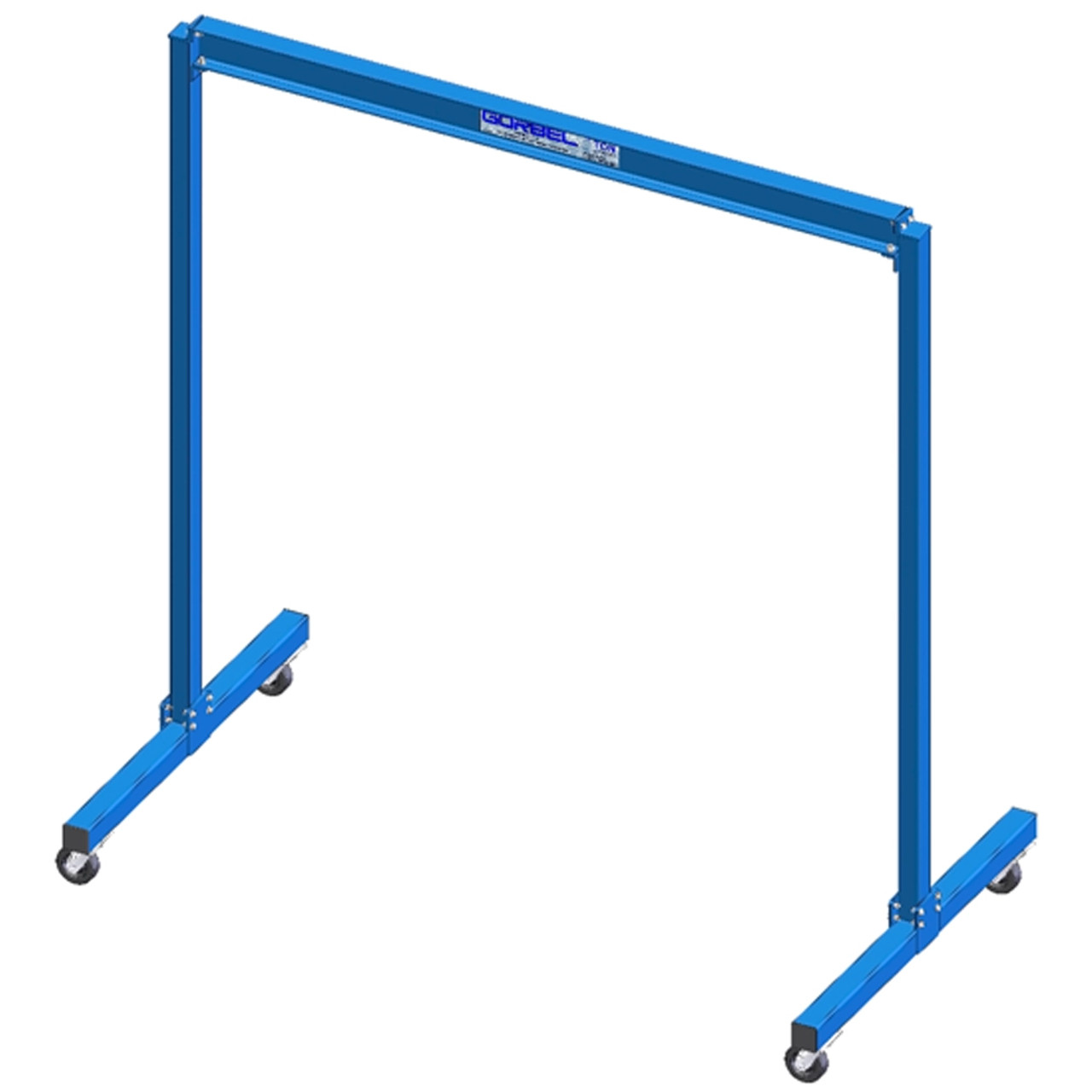
INTRODUCTION
>Dimensions contained in this installation manual are for reference only and may differ for your particular application. Please refer to the enclosed General Arrangement Drawing for actual dimensions.
Normal safety precautions: These include, but are not limited to:
• Checking for obstructions in crane travel
• Checking that all bolts are tight and have lockwashers
• Making sure that festooning cannot be snagged or pinched, whether it is electric or pneumatic
• Checking for any other unsafe conditions
INSTALLATION
>
STEP 1 - PRE-ASSEMBLY
1.1 Check packing list to make sure correct quantity of parts is included. Review supplied hardware sizes for proper tool selection.
1.2 Tools and materials (by others) typically needed to assemble crane are as follows:
• Ladders/man lifts
• Tape measure, combination wrenches, socket sets
• Spud Wrench
• Lifting sling (rated for 4000 lbs. capacity minimum)
• Mallet
• Lifting device to lift heavy Gantry Crane components
• Shop brush
• Leveling tools
• Torque wrench
• Safety equipment (hard hats, barricades, etc.)
STEP 2 – BLOCKING AND BOOM TO VERTICAL SUPPORT WELDMENTS CONN.
2.1 Assemble your Gantry Crane in a clear area free of obstructions (refer to enclosed General Arrangement Drawing for overall size, other relevant dimensions and hardware locations).
2.2 Layout and block up Gantry (as shown in Diagram 2A). Block up high enough to install trolley and (optional) Tag Line Bracket and to facilitate hardware installation.
TIP : For easiest installation, install trolley while Boom is on its side. To order hoist and trolley (ordered separately), select Jib for Crane Type, enter Height under Boom and enter the Beam Size of the Gantry found on the General Arrangement Drawing.
2.3 Install hoist or hoist trolley onto wide flange beam per instructions supplied with trolley (as shown in Diagram 2B). If wheels will clear Boom End Plate, Trolley may be bench assembled with Suspension Plate and adjusted for the beam width. If Trolley Wheels will not pass by Boom End Plate, Trolley halves will need to be assembled on beam..
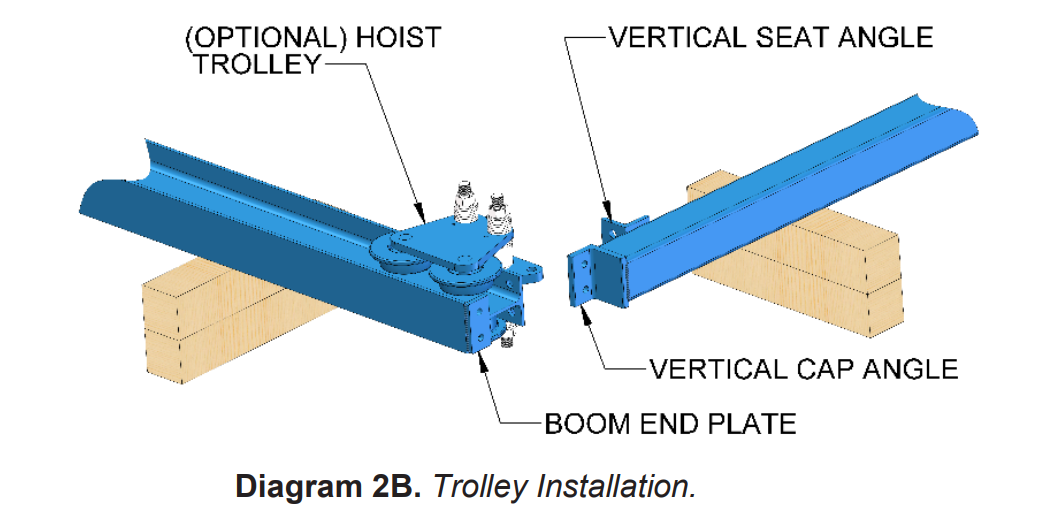
2.4 Align Boom and Vertical Support Weldment connection holes. Install Boom/Vertical Seat Hardware (as shown in Diagram 2C). Seat hardware may consist of two or four bolts per weldment. Snug tighten. Torque tightening will be done after the connection is checked for squareness. To protect coating, only torque head or nut on flat washer. Split lock washer side should remain stationary

TIP : Use Spud wrench to align first holes
2.5 Install Boom End Plate/Vertical Cap Hardware (as shown in Diagram 2D). If Tag Line Option was ordered, install Tag Line Bracket using Boom End Plate/Vertical Cap Hardware. Note, Tag Line Bracket has additional holes for use with multiple configurations, align appropriate holes for this connection. Some holes in bracket may be oversized. Extra Washers may be required to prevent interference of Tag Line Bracket with corner radius of Vertical Cap Angle. Snug tighten hardware. Verify mating surfaces are making full contact.

2.6 Check connections for squareness. Locate a point on the inside of the Vertical Tube 48 inches below the bottom of the Boom. Locate a point on the bottom of the Boom 48 inches from the Vertical Tube. Measure the distance between these points. If it measures outside of the range (as shown in Diagram 2E), shimming is required. If shimming is needed, loosen hardware and place an appropriate shim (provided by others) between the Boom End Plate and the Vertical Cap Angle either on top or on bottom (see Diagram 2E). Tighten hardware and re-measure
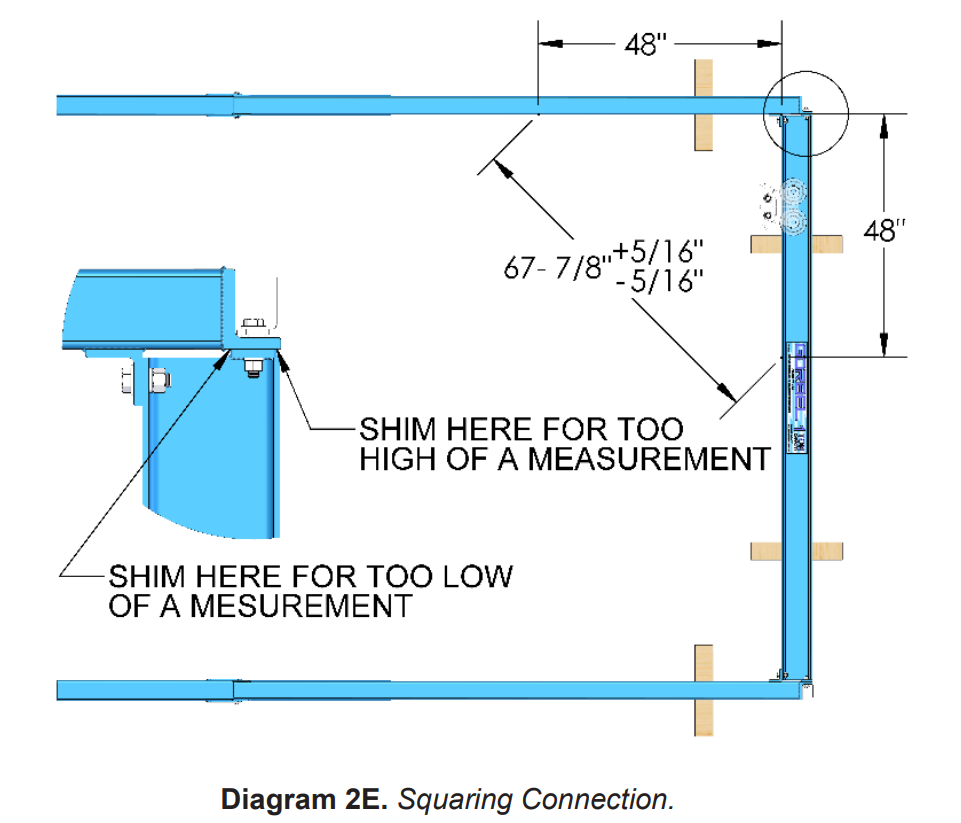
2.7 Tighten all Boom to Vertical Support hardware (refer to Chart 1, for proper torque rating).
STEP 3 –SUPPORT WELDMENTS PIVOT CONNECTION
3.1 Use protective material between floor and Horizontal Support Weldments and also between Horizontal and Vertical Support Tubes to protect the paint coating
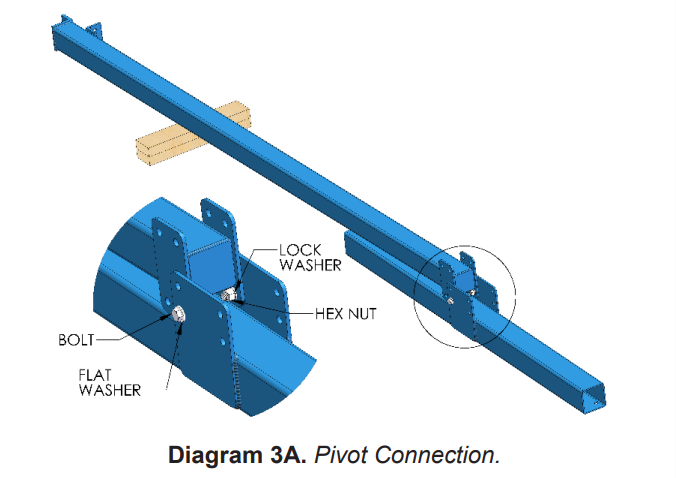
3.2 Carefully position Vertical Support Weldment Connection Plates between Horizontal Support Connection Plates using appropriate rigging (straps/slings are preferred to reduce paint damage). Align lowest Connection Plate holes on one side and assemble hardware (as shown in Diagram 2B). Do not tighten this hardware until Step 4 when remaining Connection Plate hardware is installed. For tall 5 Ton Gantries with a 10” Horizontal Tube, Spacer Plates, GANF039, are part of this assembly (see Diagram 2C).
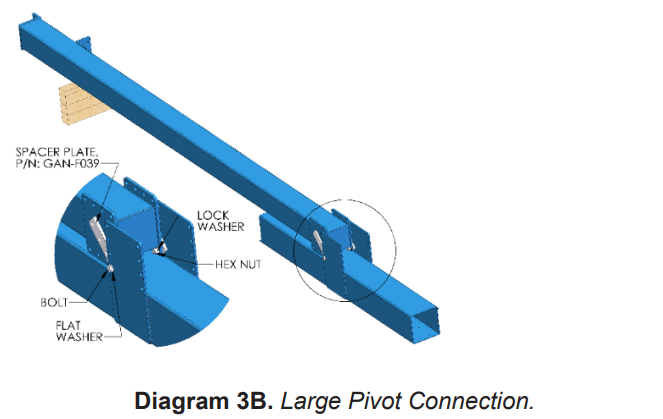
STEP 4 – PIVOT GANTRY AND COMPLETE SUPPORT CONNECTIONS
4.1 Carefully and safely, by means of rigging that is sized and oriented correctly for raising the load and by means of an overhead lifting device or lift truck, lift and rotate the Boom and the Vertical Supports by pivoting on the Horizontal Supports (as shown in Diagram 4A).
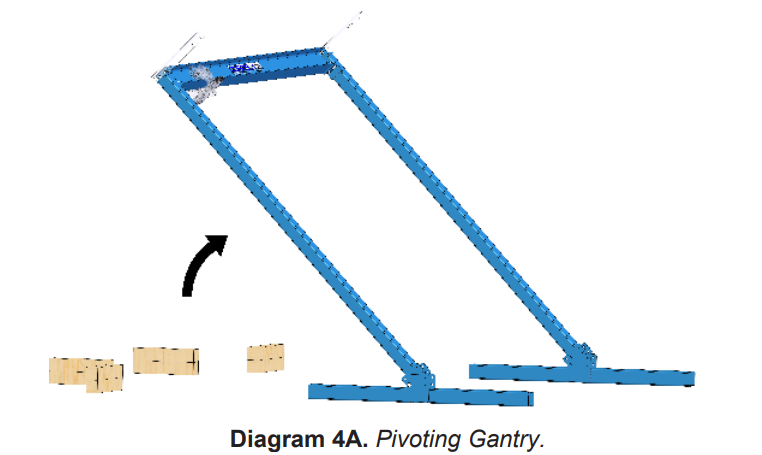
4.2 Align remaining holes in the Vertical and Horizontal Connection Plates and install hardware (and spacer plates if required) (as shown in Diagram 4B). Connection Plates may have 4, 6 or 8 holes. Install hardware in all the Connection Plate holes. Loosely tighten.

4.3 Using a level, vertically align Vertical Support Tubes and tighten all Connection Plate hardware (refer to Chart 1, for proper torque rating).
STEP 5 - CASTER TO HORIZONTAL SUPPORT CONNECTIONS
5.1 Raise Gantry and block up under Horizontal Tubes (as shown in Diagram 5A).

5.2 Install Casters and 4-Position Swivel Locks with supplied hardware (as shown in Diagram 5B) and snug tighten. Flat Washers must be installed over slotted holes. 4-Position Swivel Locks are standard and are to be used to facilitate movement of Gantry while loaded.

TIP : Choose the 2 outer-most slotted holes when mounting the 4PSL. This will ensure that the 4PSL pull ring will be accessible from the outside of the horizontal support tube allowing you to engage or disengage the spring loaded pin from the locking caster slots.
5.3 Engage Swivel Lock and check squareness of Caster Wheel relative to the Horizontal Tube in each locked position. Align Caster as required and tighten Hardware (refer to Chart 1A, for proper torque rating).
5.4 Raise Gantry, remove blocking and lower Gantry.
5.5 As an alternative, on smaller Gantries, the Casters and Swivel Locks may be installed prior to Step 3 on the Horizontal Supports. This will avoid Steps 5.1 and 5.4. Note, if doing this, more blocking may be required in Step 2 and in Step 3, the Boom may need to be tilted.
5.6 For Casters with Cam Brakes, adjustment may be required to prevent the Foot Pedal from disengaging from the Cam (as shown in Diagram 5C). If the Foot Pedal has come off the Cam, loosen Axle enough to allow Foot Pedal to move on top of the Cam. Tighten axle hardware. Test brake by carefully depressing Foot Pedal until it is horizontal see Diagram 5D). If more braking is required, release brake by pressing opposite foot pedal until it is hard stopped (see Diagram 5E) and further tighten axle hardware.

STEP 6 – OPTIONAL TAGLINE INSTALLATION
6.1 See Step 3 for installation of Tagline Brackets.
6.2 Install Eyebolt. Thread wire through eyebolt and loop. Use wire rope clamp to secure wire end back unto wire. Repeat on other end while removing slack in the wire rope.
6.3Tension wire by holding eye of bolt and drawing eyebolt further into bracket. Lock eyebolt in place by tightening hex nuts. Note, do not over tension, wire rope requires some sag in a horizontal line. There should a minimum of about an inch of sag in for every 10 feet of length.
6.4 Attach S-hooks and run festoon cable (by others) through the Shooks. Squeeze S-hooks to grip cable or hose.
6.5 Wire your Gorbel® hoist (purchased separately) per instructions supplied with the hoist.
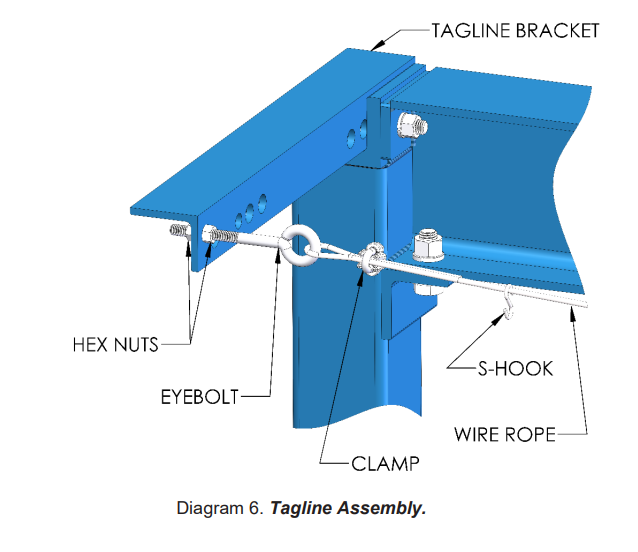
STEP 7 – OPTIONAL BUMPER INSTALLATION
7.1 Install Bumpers on Clamps so that bumpers will be facing toward the center of the Beam using 5/16” hardware and tighten
7.2 Loosely position Clamps on Beam in desired location to prevent hoist from impacting the Vertical Support using 3/8” hardware in hole closest to Beam (as shown in Diagram 7). Note, the lower hole on Beam Clamp is not used. Roll trolley up to bumpers and verify position of Clamps. Tighten 3/8” hardware (refer to Chart 1, for proper torque rating).
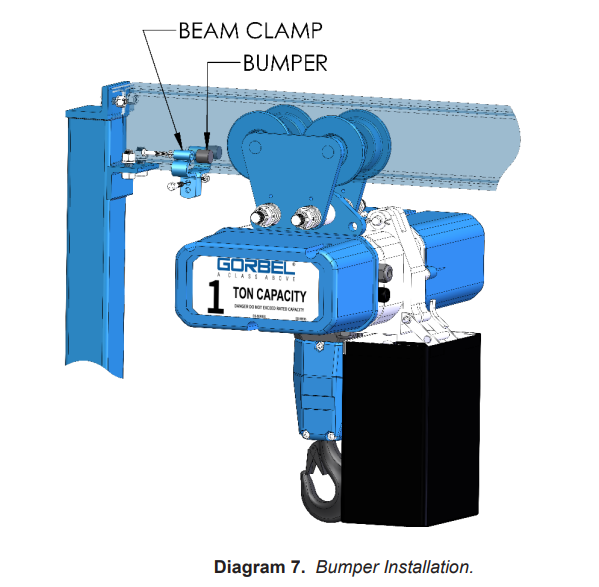
Note, Vertical Supports act as the Gantry’s End Stops. Bumpers are recommended to prevent damage to hoist from impacting Vertical Support should it be handled roughly.
STEP 8 - FINAL STEPS
8.1 Check to make sure all bolts are tight and lockwashers are compressed
8.2 Install Horizontal Support Tube End Caps. For 6” width and less tubes, rotate Swivel Lock Ring so that it is horizontal (as shown in Diagram 8A) and push in plastic End Plug. A soft blow hammer may be required. For tube widths greater than 6”, metal End Covers are provided. Use supplied #6-32 hardware to install these (see Diagram 8B).
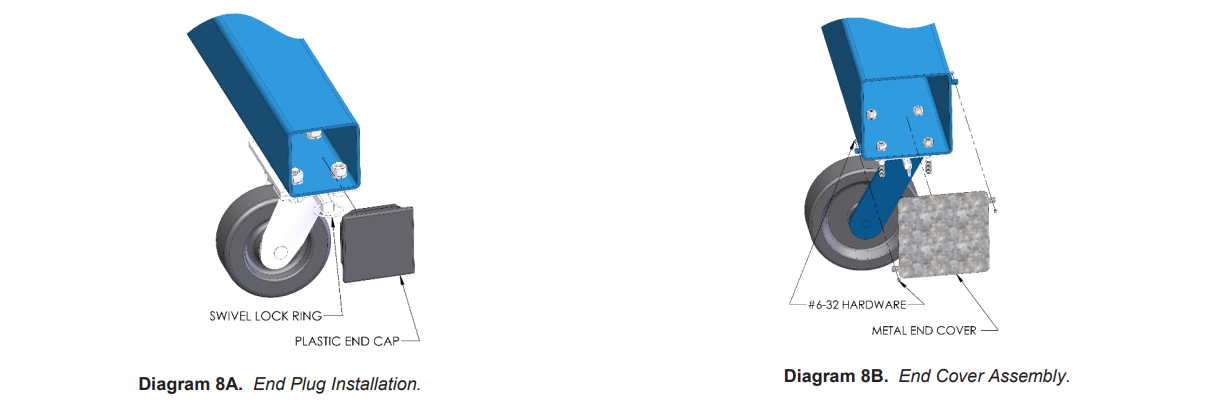
8.3 If necessary, touch up Gantry Crane with paint provided.
8.4 Keep Packing List, Installation Manual, General Arrangement Drawing, and any other inserts filed together in a safe place.
8.5 For Gantry Cranes utilizing optional Steel V-Groove Casters only: Install the assembled Gantry Crane onto the V-Track per the manufacturer’s instructions
1.1 Check packing list to make sure correct quantity of parts is included. Review supplied hardware sizes for proper tool selection.

1.2 Tools and materials (by others) typically needed to assemble crane are as follows:
• Ladders/man lifts
• Tape measure, combination wrenches, socket sets
• Spud Wrench
• Lifting sling (rated for 4000 lbs. capacity minimum)
• Mallet
• Lifting device to lift heavy Gantry Crane components
• Shop brush
• Leveling tools
• Torque wrench
• Safety equipment (hard hats, barricades, etc.)
STEP 2 – BLOCKING AND BOOM TO VERTICAL SUPPORT WELDMENTS CONN.
2.1 Assemble your Gantry Crane in a clear area free of obstructions (refer to enclosed General Arrangement Drawing for overall size, other relevant dimensions and hardware locations).
2.2 Layout and block up Gantry (as shown in Diagram 2A). Block up high enough to install trolley and (optional) Tag Line Bracket and to facilitate hardware installation.

TIP : For easiest installation, install trolley while Boom is on its side. To order hoist and trolley (ordered separately), select Jib for Crane Type, enter Height under Boom and enter the Beam Size of the Gantry found on the General Arrangement Drawing.
2.3 Install hoist or hoist trolley onto wide flange beam per instructions supplied with trolley (as shown in Diagram 2B). If wheels will clear Boom End Plate, Trolley may be bench assembled with Suspension Plate and adjusted for the beam width. If Trolley Wheels will not pass by Boom End Plate, Trolley halves will need to be assembled on beam..

2.4 Align Boom and Vertical Support Weldment connection holes. Install Boom/Vertical Seat Hardware (as shown in Diagram 2C). Seat hardware may consist of two or four bolts per weldment. Snug tighten. Torque tightening will be done after the connection is checked for squareness. To protect coating, only torque head or nut on flat washer. Split lock washer side should remain stationary

TIP : Use Spud wrench to align first holes
2.5 Install Boom End Plate/Vertical Cap Hardware (as shown in Diagram 2D). If Tag Line Option was ordered, install Tag Line Bracket using Boom End Plate/Vertical Cap Hardware. Note, Tag Line Bracket has additional holes for use with multiple configurations, align appropriate holes for this connection. Some holes in bracket may be oversized. Extra Washers may be required to prevent interference of Tag Line Bracket with corner radius of Vertical Cap Angle. Snug tighten hardware. Verify mating surfaces are making full contact.

2.6 Check connections for squareness. Locate a point on the inside of the Vertical Tube 48 inches below the bottom of the Boom. Locate a point on the bottom of the Boom 48 inches from the Vertical Tube. Measure the distance between these points. If it measures outside of the range (as shown in Diagram 2E), shimming is required. If shimming is needed, loosen hardware and place an appropriate shim (provided by others) between the Boom End Plate and the Vertical Cap Angle either on top or on bottom (see Diagram 2E). Tighten hardware and re-measure

2.7 Tighten all Boom to Vertical Support hardware (refer to Chart 1, for proper torque rating).
STEP 3 –SUPPORT WELDMENTS PIVOT CONNECTION
3.1 Use protective material between floor and Horizontal Support Weldments and also between Horizontal and Vertical Support Tubes to protect the paint coating

3.2 Carefully position Vertical Support Weldment Connection Plates between Horizontal Support Connection Plates using appropriate rigging (straps/slings are preferred to reduce paint damage). Align lowest Connection Plate holes on one side and assemble hardware (as shown in Diagram 2B). Do not tighten this hardware until Step 4 when remaining Connection Plate hardware is installed. For tall 5 Ton Gantries with a 10” Horizontal Tube, Spacer Plates, GANF039, are part of this assembly (see Diagram 2C).

STEP 4 – PIVOT GANTRY AND COMPLETE SUPPORT CONNECTIONS
4.1 Carefully and safely, by means of rigging that is sized and oriented correctly for raising the load and by means of an overhead lifting device or lift truck, lift and rotate the Boom and the Vertical Supports by pivoting on the Horizontal Supports (as shown in Diagram 4A).

4.2 Align remaining holes in the Vertical and Horizontal Connection Plates and install hardware (and spacer plates if required) (as shown in Diagram 4B). Connection Plates may have 4, 6 or 8 holes. Install hardware in all the Connection Plate holes. Loosely tighten.

4.3 Using a level, vertically align Vertical Support Tubes and tighten all Connection Plate hardware (refer to Chart 1, for proper torque rating).
STEP 5 - CASTER TO HORIZONTAL SUPPORT CONNECTIONS
5.1 Raise Gantry and block up under Horizontal Tubes (as shown in Diagram 5A).

5.2 Install Casters and 4-Position Swivel Locks with supplied hardware (as shown in Diagram 5B) and snug tighten. Flat Washers must be installed over slotted holes. 4-Position Swivel Locks are standard and are to be used to facilitate movement of Gantry while loaded.

TIP : Choose the 2 outer-most slotted holes when mounting the 4PSL. This will ensure that the 4PSL pull ring will be accessible from the outside of the horizontal support tube allowing you to engage or disengage the spring loaded pin from the locking caster slots.
5.3 Engage Swivel Lock and check squareness of Caster Wheel relative to the Horizontal Tube in each locked position. Align Caster as required and tighten Hardware (refer to Chart 1A, for proper torque rating).
5.4 Raise Gantry, remove blocking and lower Gantry.
5.5 As an alternative, on smaller Gantries, the Casters and Swivel Locks may be installed prior to Step 3 on the Horizontal Supports. This will avoid Steps 5.1 and 5.4. Note, if doing this, more blocking may be required in Step 2 and in Step 3, the Boom may need to be tilted.
5.6 For Casters with Cam Brakes, adjustment may be required to prevent the Foot Pedal from disengaging from the Cam (as shown in Diagram 5C). If the Foot Pedal has come off the Cam, loosen Axle enough to allow Foot Pedal to move on top of the Cam. Tighten axle hardware. Test brake by carefully depressing Foot Pedal until it is horizontal see Diagram 5D). If more braking is required, release brake by pressing opposite foot pedal until it is hard stopped (see Diagram 5E) and further tighten axle hardware.

STEP 6 – OPTIONAL TAGLINE INSTALLATION
6.1 See Step 3 for installation of Tagline Brackets.
6.2 Install Eyebolt. Thread wire through eyebolt and loop. Use wire rope clamp to secure wire end back unto wire. Repeat on other end while removing slack in the wire rope.
6.3Tension wire by holding eye of bolt and drawing eyebolt further into bracket. Lock eyebolt in place by tightening hex nuts. Note, do not over tension, wire rope requires some sag in a horizontal line. There should a minimum of about an inch of sag in for every 10 feet of length.
6.4 Attach S-hooks and run festoon cable (by others) through the Shooks. Squeeze S-hooks to grip cable or hose.
6.5 Wire your Gorbel® hoist (purchased separately) per instructions supplied with the hoist.

STEP 7 – OPTIONAL BUMPER INSTALLATION
7.1 Install Bumpers on Clamps so that bumpers will be facing toward the center of the Beam using 5/16” hardware and tighten
7.2 Loosely position Clamps on Beam in desired location to prevent hoist from impacting the Vertical Support using 3/8” hardware in hole closest to Beam (as shown in Diagram 7). Note, the lower hole on Beam Clamp is not used. Roll trolley up to bumpers and verify position of Clamps. Tighten 3/8” hardware (refer to Chart 1, for proper torque rating).

Note, Vertical Supports act as the Gantry’s End Stops. Bumpers are recommended to prevent damage to hoist from impacting Vertical Support should it be handled roughly.
STEP 8 - FINAL STEPS
8.1 Check to make sure all bolts are tight and lockwashers are compressed
8.2 Install Horizontal Support Tube End Caps. For 6” width and less tubes, rotate Swivel Lock Ring so that it is horizontal (as shown in Diagram 8A) and push in plastic End Plug. A soft blow hammer may be required. For tube widths greater than 6”, metal End Covers are provided. Use supplied #6-32 hardware to install these (see Diagram 8B).

8.3 If necessary, touch up Gantry Crane with paint provided.
8.4 Keep Packing List, Installation Manual, General Arrangement Drawing, and any other inserts filed together in a safe place.
8.5 For Gantry Cranes utilizing optional Steel V-Groove Casters only: Install the assembled Gantry Crane onto the V-Track per the manufacturer’s instructions
GENERAL LAYOUT DRAWING
>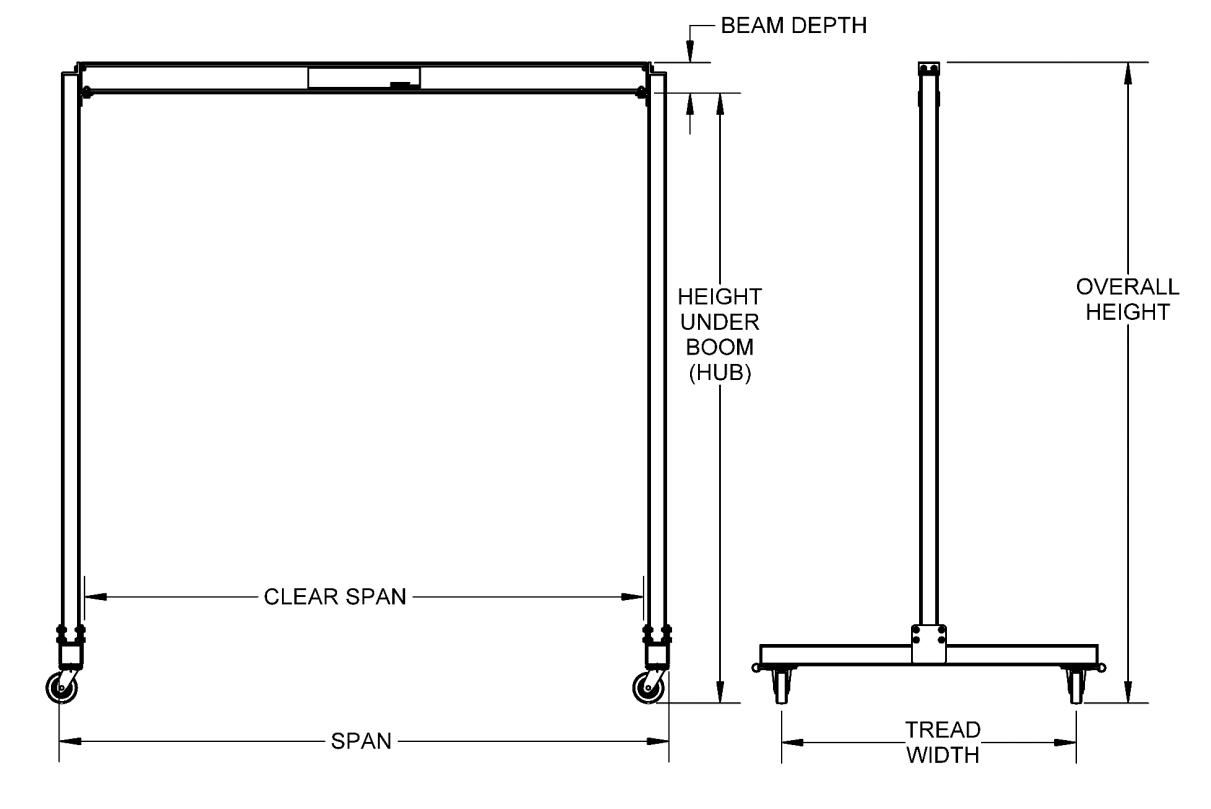
CRANE OPERATOR INSTRUCTIONS
>
Overhead cranes and gantry cranes generally handle materials over working areas where there are personnel.
Therefore, it is important for the Crane Operator to be instructed in the use of the crane and to understand the
severe consequences of careless operation. It is not intended that these suggestions take precedence over existing
plant safety rules and regulations or OSHA regulations. However, a thorough study of the following information
should provide a better understanding of safe operation and afford a greater margin of safety for people and
machinery on the plant floor. It must be recognized that these are suggestions for the Crane Operator’s use. It is the
responsibility of the owner to make personnel aware of all federal, state and local rules and codes, and to make
certain operators are properly trained.
Qualifications Crane operation, to be safe and efficient, requires skill: the exercise of extreme care and good judgment, alertness and concentration, and rigid adherence to proven safety rules and practices as outlined in applicable and current ANSI and OSHA safety standards. In general, no person should be permitted to operate a crane:
• Who cannot speak the appropriate language or read and understand the printed instructions.
• Who is not of legal age to operate this type of equipment.
• Whose hearing or eyesight is impaired (unless suitably corrected with good depth perception).
• Who may be suffering from heart or other ailments which might interfere with the operator’s safe performance.
• Unless the operator has carefully read and studied this operation manual.
• Unless the operator has been properly instructed.
• Unless the operator has demonstrated his instructions through practical operation.
• Unless the operator is familiar with hitching equipment and safe hitching equipment practices.
Handling the Trolley Motion
Before a load is handled, the hoist should be positioned directly over the load that is to be handled. When the slack is taken out of the slings, if the hoist is not directly over the load, bring it directly over the load before hoisting is continued. Failure to center the hoist over the load may cause the load to swing upon lifting or the gantry to abruptly move. Always start the trolley motion slowly and reduce the trolley speed gradually.
Handling the Hoist Motion
Refer to the lifting (hoist) equipment’s operating instructions.
Handling the Crane Motion
Use extreme caution if moving the gantry crane while loaded. Prior to moving the loaded gantry crane the following precautions are required. Plan the movement and verify the path is clear of any obstructions that may hinder the caster wheel motion. Center gantry over load, orient casters in the direction of movement and engage swivel locks on the two leading casters. The General Layout Drawing shows casters in correct position to move the gantry to the right in a direction parallel to the boom. Lift the load, refer to the lifting (hoist) equipment’s operating instructions. Keep the load as close to the ground as possible. Two operators are required. An operator shall be positioned outside of each leg, with one pushing and the other pulling the support leg for movements parallel to the boom and both operators pushing for movements perpendicular to the boom. WARNING! Never move the gantry while standing between the support legs. The trolley may suddenly move and the lifted load may strike the operator.
Qualifications Crane operation, to be safe and efficient, requires skill: the exercise of extreme care and good judgment, alertness and concentration, and rigid adherence to proven safety rules and practices as outlined in applicable and current ANSI and OSHA safety standards. In general, no person should be permitted to operate a crane:
• Who cannot speak the appropriate language or read and understand the printed instructions.
• Who is not of legal age to operate this type of equipment.
• Whose hearing or eyesight is impaired (unless suitably corrected with good depth perception).
• Who may be suffering from heart or other ailments which might interfere with the operator’s safe performance.
• Unless the operator has carefully read and studied this operation manual.
• Unless the operator has been properly instructed.
• Unless the operator has demonstrated his instructions through practical operation.
• Unless the operator is familiar with hitching equipment and safe hitching equipment practices.
Handling the Trolley Motion
Before a load is handled, the hoist should be positioned directly over the load that is to be handled. When the slack is taken out of the slings, if the hoist is not directly over the load, bring it directly over the load before hoisting is continued. Failure to center the hoist over the load may cause the load to swing upon lifting or the gantry to abruptly move. Always start the trolley motion slowly and reduce the trolley speed gradually.
Handling the Hoist Motion
Refer to the lifting (hoist) equipment’s operating instructions.
Handling the Crane Motion
Use extreme caution if moving the gantry crane while loaded. Prior to moving the loaded gantry crane the following precautions are required. Plan the movement and verify the path is clear of any obstructions that may hinder the caster wheel motion. Center gantry over load, orient casters in the direction of movement and engage swivel locks on the two leading casters. The General Layout Drawing shows casters in correct position to move the gantry to the right in a direction parallel to the boom. Lift the load, refer to the lifting (hoist) equipment’s operating instructions. Keep the load as close to the ground as possible. Two operators are required. An operator shall be positioned outside of each leg, with one pushing and the other pulling the support leg for movements parallel to the boom and both operators pushing for movements perpendicular to the boom. WARNING! Never move the gantry while standing between the support legs. The trolley may suddenly move and the lifted load may strike the operator.
GENERAL SUGGESTIONS
>
Know Your Crane
Crane operators should be familiar with the principal parts of a crane and have a thorough knowledge of crane control functions and movements. The crane operator should be required to know the location and proper operation of the main conductor disconnecting means for all power to the attachments on the crane.
Responsibility
Each crane operator should be held directly responsible for the safe operation of the crane. Whenever there is any doubt as to SAFETY, the crane operator should stop the crane and refuse to handle loads until: (1) safety has been assured or (2) the operator has been ordered to proceed by the supervisor, who then assumes all responsibility for the SAFETY of the lift. Do not permit ANYONE to ride on the hook or a load
Inspection
Test the crane movement and any attachments on the crane at the beginning of each shift. Whenever the operator finds anything wrong or apparently wrong, the problem should be reported immediately to the proper supervisor and appropriate corrective action taken.
Operating Suggestions
One measure of a good crane operator is the smoothness of the crane operation. The good crane operator should know and follow these proven suggestions for safe, efficient crane handling.
1. The crane should be moved smoothly and gradually to avoid abrupt, jerky movements of the load. Slack must be removed from the sling and hoisting ropes before the load is lifted.
2. Center the crane over the load before starting the hoist to avoid swinging the load as the lift is started. Loads should not be swung by the crane to reach areas not under the crane.
3. Crane-hoisting ropes should be kept vertical. Cranes shall not be used for side pulls.
4. Be sure everyone in the immediate area is clear of the load and aware that a load is being moved.
5. Do not make lifts beyond the rated load capacity of the crane, sling chains, rope slings, etc.
6. Make certain that before moving the load, load slings, load chains, or other lifting devices are fully seated in the saddle of the hook with hook latch closed (if equipped with hook latch).
7. Check to be sure that the load and/or bottom block is lifted high enough to clear all obstructions when moving gantry or trolley.
8. At no time should a load be left suspended from the crane unless the operator has the push button with the power on, and under this condition keep the load as close as possible to the floor to minimize the possibility of an injury if the load should drop. When the crane is holding a load, the crane operator should remain at the push button.
9. Do not lift loads with sling hooks hanging loose. If all sling hooks are not needed, they should be properly stored, or use a different sling.
10. All slings or cables should be removed from the crane hooks when not in use (dangling cables or hooks hung in sling rings can inadvertently snag other objects when the crane is moving).
11. Operators shall not carry loads and/or empty bottom blocks over personnel. Particular additional caution should be practiced when using magnet or vacuum devices. Loads, or parts of loads, held magnetically could drop. Failure of power to magnets or vacuum devices can result in dropping the load. Extra precaution should be exercised when handling molten metal in the proximity of personnel.
12. Whenever the operator leaves the crane the following procedure should be followed:
• Raise all hooks to an intermediate position.
• Spot the crane at an approved designated location.
• Place all controls in the “off” position.
• Open the main switch to the “off” position.
• Make visual check before leaving the crane.
13. In case of emergency or during inspection, repairing, cleaning or lubrication, a warning sign or signal should be displayed and the main switch should be locked in the “off” position. This should be done whether the work is being done by the crane operator or by others.
14. Contact with bumpers or end stops shall be made with extreme caution. The operator should do so with particular care for the safety of persons below the crane, and only after making certain that any persons on the other cranes are aware of what is being done.
15. ANY SAFETY FEATURES AND MECHANISMS BUILT-IN OR OTHERWISE PROVIDED WITH THE CRANE BY GORBEL ARE REQUIRED FOR THE SAFE OPERATION OF THE CRANE. DO NOT, UNDER ANY CIRCUMSTANCES, REMOVE OR OTHERWISE IMPAIR OR DISABLE THE PROPER FUNCTIONING OF ANY CRANE SAFETY MECHANISMS OR FEATURES BUILT-IN OR OTHERWISE PROVIDED BY GORBEL FOR SAFE OPERATION OF THE CRANE. ANY REMOVAL, IMPAIRMENT OR DISABLING OF ANY SUCH SAFETY MECHANISMS OR FEATURES OR OTHER USE OR OPERATION OF THE CRANE WITHOUT THE COMPLETE AND PROPER FUNCTIONING OF ANY SUCH SAFETY MECHANISMS OR FEATURES AUTOMATICALLY AND IMMEDIATELY VOIDS ANY AND ALL EXPRESS AND IMPLIED WARRANTIES OF ANY KIND OR NATURE.
Crane operators should be familiar with the principal parts of a crane and have a thorough knowledge of crane control functions and movements. The crane operator should be required to know the location and proper operation of the main conductor disconnecting means for all power to the attachments on the crane.
Responsibility
Each crane operator should be held directly responsible for the safe operation of the crane. Whenever there is any doubt as to SAFETY, the crane operator should stop the crane and refuse to handle loads until: (1) safety has been assured or (2) the operator has been ordered to proceed by the supervisor, who then assumes all responsibility for the SAFETY of the lift. Do not permit ANYONE to ride on the hook or a load
Inspection
Test the crane movement and any attachments on the crane at the beginning of each shift. Whenever the operator finds anything wrong or apparently wrong, the problem should be reported immediately to the proper supervisor and appropriate corrective action taken.
Operating Suggestions
One measure of a good crane operator is the smoothness of the crane operation. The good crane operator should know and follow these proven suggestions for safe, efficient crane handling.
1. The crane should be moved smoothly and gradually to avoid abrupt, jerky movements of the load. Slack must be removed from the sling and hoisting ropes before the load is lifted.
2. Center the crane over the load before starting the hoist to avoid swinging the load as the lift is started. Loads should not be swung by the crane to reach areas not under the crane.
3. Crane-hoisting ropes should be kept vertical. Cranes shall not be used for side pulls.
4. Be sure everyone in the immediate area is clear of the load and aware that a load is being moved.
5. Do not make lifts beyond the rated load capacity of the crane, sling chains, rope slings, etc.
6. Make certain that before moving the load, load slings, load chains, or other lifting devices are fully seated in the saddle of the hook with hook latch closed (if equipped with hook latch).
7. Check to be sure that the load and/or bottom block is lifted high enough to clear all obstructions when moving gantry or trolley.
8. At no time should a load be left suspended from the crane unless the operator has the push button with the power on, and under this condition keep the load as close as possible to the floor to minimize the possibility of an injury if the load should drop. When the crane is holding a load, the crane operator should remain at the push button.
9. Do not lift loads with sling hooks hanging loose. If all sling hooks are not needed, they should be properly stored, or use a different sling.
10. All slings or cables should be removed from the crane hooks when not in use (dangling cables or hooks hung in sling rings can inadvertently snag other objects when the crane is moving).
11. Operators shall not carry loads and/or empty bottom blocks over personnel. Particular additional caution should be practiced when using magnet or vacuum devices. Loads, or parts of loads, held magnetically could drop. Failure of power to magnets or vacuum devices can result in dropping the load. Extra precaution should be exercised when handling molten metal in the proximity of personnel.
12. Whenever the operator leaves the crane the following procedure should be followed:
• Raise all hooks to an intermediate position.
• Spot the crane at an approved designated location.
• Place all controls in the “off” position.
• Open the main switch to the “off” position.
• Make visual check before leaving the crane.
13. In case of emergency or during inspection, repairing, cleaning or lubrication, a warning sign or signal should be displayed and the main switch should be locked in the “off” position. This should be done whether the work is being done by the crane operator or by others.
14. Contact with bumpers or end stops shall be made with extreme caution. The operator should do so with particular care for the safety of persons below the crane, and only after making certain that any persons on the other cranes are aware of what is being done.
15. ANY SAFETY FEATURES AND MECHANISMS BUILT-IN OR OTHERWISE PROVIDED WITH THE CRANE BY GORBEL ARE REQUIRED FOR THE SAFE OPERATION OF THE CRANE. DO NOT, UNDER ANY CIRCUMSTANCES, REMOVE OR OTHERWISE IMPAIR OR DISABLE THE PROPER FUNCTIONING OF ANY CRANE SAFETY MECHANISMS OR FEATURES BUILT-IN OR OTHERWISE PROVIDED BY GORBEL FOR SAFE OPERATION OF THE CRANE. ANY REMOVAL, IMPAIRMENT OR DISABLING OF ANY SUCH SAFETY MECHANISMS OR FEATURES OR OTHER USE OR OPERATION OF THE CRANE WITHOUT THE COMPLETE AND PROPER FUNCTIONING OF ANY SUCH SAFETY MECHANISMS OR FEATURES AUTOMATICALLY AND IMMEDIATELY VOIDS ANY AND ALL EXPRESS AND IMPLIED WARRANTIES OF ANY KIND OR NATURE.
LIMITED WARRANTY
>
It is agreed that the equipment purchased hereunder is subject to the following LIMITED warranty and no other. Gorbel Incorporated (“Gorbel”) warrants the manual
push-pull Work Station Cranes, Jib Crane, and Gantry Crane products to be free from defects in material or workmanship for a period of ten years or 20,000 hours
use from date of shipment. Gorbel warrants the Motorized Work Station Cranes and Jib Crane products to be free from defects in material or workmanship for a
period of two years or 4,000 hours use from the date of shipment. Gorbel warrants the G-Force® and Easy Arm™ products to be free from defects in material or
workmanship for a period of one year or 2,000 hours use from the date of shipment. This warranty does not cover Gantry Crane wheels. This warranty shall not cover
failure or defective operation caused by operation in excess of recommended capacities, misuses, negligence or accident, and alteration or repair not authorized by
Gorbel. No system shall be field modified after manufacture without the written authorization of Gorbel, Inc. Any field modification made to the system without the
written authorization of Gorbel, Inc. shall void Gorbel’s warranty obligation. OTHER THAN AS SET FORTH HEREIN, NO OTHER EXPRESS WARRANTIES,
AND NO IMPLIED WARRANTIES, ORAL OR WRITTEN, INCLUDING BUT NOT LIMITED TO THE WARRANTIES OF MERCHANTABILITY OR FITNESS FOR
A PARTICULAR PURPOSE, ARE MADE BY GORBEL WITH RESPECT TO ITS PRODUCTS AND ALL SUCH WARRANTIES ARE HEREBY SPECIFICALLY
DISCLAIMED. GORBEL SHALL NOT BE LIABLE UNDER ANY CIRCUMSTANCES FOR ANY INCIDENTAL, SPECIAL AND/OR CONSEQUENTIAL DAMAGES
WHATSOEVER, WHETHER OR NOT FORESEEABLE, INCLUDING BUT NOT LIMITED TO DAMAGES FOR LOST PROFITS AND ALL SUCH INCIDENTAL,
SPECIAL AND/OR CONSEQUENTIAL DAMAGES ARE HEREBY ALSO SPECIFICALLY DISCLAIMED. Gorbel’s obligation and Purchaser’s or end user’s sole
remedy under this warranty is limited to the replacement or repair of Gorbel’s products at the factory, or at the discretion of Gorbel, at a location designated by Gorbel.
Purchaser or end user shall be solely responsible for all freight and transportation costs incurred in connection with any warranty work provided by Gorbel hereunder.
Gorbel will not be liable for any loss, injury or damage to persons or property, nor for damages of any kind resulting from failure or defective operation of any materials
or equipment furnished hereunder. Components and accessories not manufactured by Gorbel are not included in this warranty. Purchaser’s or end user’s remedy for
components and accessories not manufactured by Gorbel is limited to and determined by the terms and conditions of the warranty provided by the respective
manufacturers of such components and accessories.
A) DISCLAIMER OF IMPLIED WARRANTY OF MERCHANTABILITY
Gorbel and Purchaser agree that the implied warranty of merchantability is excluded from this transaction and shall not apply to the goods involved in this transaction.
B) DISCLAIMER OF IMPLIED WARRANTY OF FITNESS FOR PARTICULAR PURPOSE
Gorbel and Purchaser agree that the implied warranty of fitness for particular purpose is excluded from this transaction and shall not apply to the goods involved in this transaction.
C) DISCLAIMER OF EXPRESS WARRANTY
Gorbel’s agents, or dealer’s agents, or distributor’s agents may have made oral statements about the machinery and equipment described in this transaction. Such statements do not constitute warranties, and Purchaser agrees not to rely on such statements. Purchaser also agrees that such statements are not part of this transaction.
D) DISCLAIMER OF SPECIAL, INCIDENTAL AND CONSEQUENTIAL DAMAGES
Gorbel and Purchaser agree that any claim made by Purchaser which is inconsistent with Gorbel’s obligations and the warranty remedies provided with Gorbel’s products, and in particular, special, incidental and consequential damages, are expressly excluded.
E) DEALER OR DISTRIBUTOR NOT AN AGENT
Gorbel and Purchaser agree that Purchaser has been put on notice that dealer or distributor is not Gorbel’s agent in any respect for any reason. Gorbel and Purchaser also agree that Purchaser has been put on notice that dealer or distributor is not authorized to incur any obligations or to make any representations or warranties on Gorbel’s behalf other than those specifically set forth in Gorbel’s warranty provided in connection with its product.
F) MERGER
This warranty agreement constitutes a final and complete written expression of all the terms and conditions of this warranty and is a complete and exclusive statement of those terms.
G) PAINTING
Every crane (excluding components) receives a quality paint job before leaving the factory. Unfortunately, no paint will protect against the abuses received during the transportation process via common carrier. We have included at least one (1) twelve ounce spray can for touchup with each crane ordered (unless special paint was specified). If additional paint is required, contact a Gorbel® Customer Service Representative at 1-800-821-0086 or 1-585-924-6262.
Title and Ownership:
Title to the machinery and equipment described in the foregoing proposal shall remain with Gorbel and shall not pass to the Purchaser until the full amount herein agreed to be paid has been fully paid in cash.
Claims and Damages:
Unless expressly stated in writing, goods and equipment shall be at Purchaser’s risk on and after Seller’s delivery in good shipping order to the Carrier. Gorbel shall in no event be held responsible for materials furnished or work performed by any person other than it or its authorized representative or agent.
Cancellations:
If it becomes necessary for the purchaser to cancel this order wholly or in part, he shall at once so advise Gorbel in writing. Upon receipt of such written notice all work will stop immediately. If the order entails only stock items, a flat restocking charge of 15% of the purchase price will become due and payable by Purchaser to Gorbel. Items purchased specifically for the canceled order shall be charged for in accordance with the cancellation charges of our supplier plus 15% for handling in our factory. The cost of material and/or labor expended in general fabrication for the order shall be charged for on the basis of total costs to Gorbel up to the time of cancellation plus 15%.
Returns:
No equipment, materials or parts may be returned to Gorbel without express permission in writing to do so. Extra Charge Delay: If Purchaser delays or interrupts progress of Seller’s performance, or causes changes to be made, Purchaser agrees to reimburse Gorbel for expense, if any, incident to such delay.
Changes and Alterations:
Gorbel reserves the right to make changes in the details of construction of the equipment, as in its judgment, will be in the interest of the Purchaser; will make any changes in or additions to the equipment which may be agreed upon in writing by the Purchaser; and Gorbel is not obligated to make such changes in products previously sold any customer.
Third Party Action:
Should Gorbel have to resort to third party action to collect any amount due after thirty (30) days from date of invoice, the Purchaser agrees to pay collection costs, reasonable attorney’s fees, court costs and legal interest.
OSHA Responsibilities:
Gorbel agrees to fully cooperate with Purchaser in the design, manufacture or procurement of safety features or devices that comply with OSHA regulations. In the event additional equipment or labor shall be furnished by Gorbel, it will be at prices and standard rates then in effect, or as may be mutually agreed upon at the time of the additional installation.
Equal Employment Opportunity:
Gorbel agrees to take affirmative action to ensure equal employment opportunity for all job applicants and employees without regard to race, color, age, religion, sex, national origin, handicap, veteran, or marital status. Gorbel agrees to maintain non-segregated work facilities and comply with rules and regulations of the Secretary of Labor or as otherwise provided by law or Executive Order.
A) DISCLAIMER OF IMPLIED WARRANTY OF MERCHANTABILITY
Gorbel and Purchaser agree that the implied warranty of merchantability is excluded from this transaction and shall not apply to the goods involved in this transaction.
B) DISCLAIMER OF IMPLIED WARRANTY OF FITNESS FOR PARTICULAR PURPOSE
Gorbel and Purchaser agree that the implied warranty of fitness for particular purpose is excluded from this transaction and shall not apply to the goods involved in this transaction.
C) DISCLAIMER OF EXPRESS WARRANTY
Gorbel’s agents, or dealer’s agents, or distributor’s agents may have made oral statements about the machinery and equipment described in this transaction. Such statements do not constitute warranties, and Purchaser agrees not to rely on such statements. Purchaser also agrees that such statements are not part of this transaction.
D) DISCLAIMER OF SPECIAL, INCIDENTAL AND CONSEQUENTIAL DAMAGES
Gorbel and Purchaser agree that any claim made by Purchaser which is inconsistent with Gorbel’s obligations and the warranty remedies provided with Gorbel’s products, and in particular, special, incidental and consequential damages, are expressly excluded.
E) DEALER OR DISTRIBUTOR NOT AN AGENT
Gorbel and Purchaser agree that Purchaser has been put on notice that dealer or distributor is not Gorbel’s agent in any respect for any reason. Gorbel and Purchaser also agree that Purchaser has been put on notice that dealer or distributor is not authorized to incur any obligations or to make any representations or warranties on Gorbel’s behalf other than those specifically set forth in Gorbel’s warranty provided in connection with its product.
F) MERGER
This warranty agreement constitutes a final and complete written expression of all the terms and conditions of this warranty and is a complete and exclusive statement of those terms.
G) PAINTING
Every crane (excluding components) receives a quality paint job before leaving the factory. Unfortunately, no paint will protect against the abuses received during the transportation process via common carrier. We have included at least one (1) twelve ounce spray can for touchup with each crane ordered (unless special paint was specified). If additional paint is required, contact a Gorbel® Customer Service Representative at 1-800-821-0086 or 1-585-924-6262.
Title and Ownership:
Title to the machinery and equipment described in the foregoing proposal shall remain with Gorbel and shall not pass to the Purchaser until the full amount herein agreed to be paid has been fully paid in cash.
Claims and Damages:
Unless expressly stated in writing, goods and equipment shall be at Purchaser’s risk on and after Seller’s delivery in good shipping order to the Carrier. Gorbel shall in no event be held responsible for materials furnished or work performed by any person other than it or its authorized representative or agent.
Cancellations:
If it becomes necessary for the purchaser to cancel this order wholly or in part, he shall at once so advise Gorbel in writing. Upon receipt of such written notice all work will stop immediately. If the order entails only stock items, a flat restocking charge of 15% of the purchase price will become due and payable by Purchaser to Gorbel. Items purchased specifically for the canceled order shall be charged for in accordance with the cancellation charges of our supplier plus 15% for handling in our factory. The cost of material and/or labor expended in general fabrication for the order shall be charged for on the basis of total costs to Gorbel up to the time of cancellation plus 15%.
Returns:
No equipment, materials or parts may be returned to Gorbel without express permission in writing to do so. Extra Charge Delay: If Purchaser delays or interrupts progress of Seller’s performance, or causes changes to be made, Purchaser agrees to reimburse Gorbel for expense, if any, incident to such delay.
Changes and Alterations:
Gorbel reserves the right to make changes in the details of construction of the equipment, as in its judgment, will be in the interest of the Purchaser; will make any changes in or additions to the equipment which may be agreed upon in writing by the Purchaser; and Gorbel is not obligated to make such changes in products previously sold any customer.
Third Party Action:
Should Gorbel have to resort to third party action to collect any amount due after thirty (30) days from date of invoice, the Purchaser agrees to pay collection costs, reasonable attorney’s fees, court costs and legal interest.
OSHA Responsibilities:
Gorbel agrees to fully cooperate with Purchaser in the design, manufacture or procurement of safety features or devices that comply with OSHA regulations. In the event additional equipment or labor shall be furnished by Gorbel, it will be at prices and standard rates then in effect, or as may be mutually agreed upon at the time of the additional installation.
Equal Employment Opportunity:
Gorbel agrees to take affirmative action to ensure equal employment opportunity for all job applicants and employees without regard to race, color, age, religion, sex, national origin, handicap, veteran, or marital status. Gorbel agrees to maintain non-segregated work facilities and comply with rules and regulations of the Secretary of Labor or as otherwise provided by law or Executive Order.
INSPECTION AND MAINTENANCE
>
